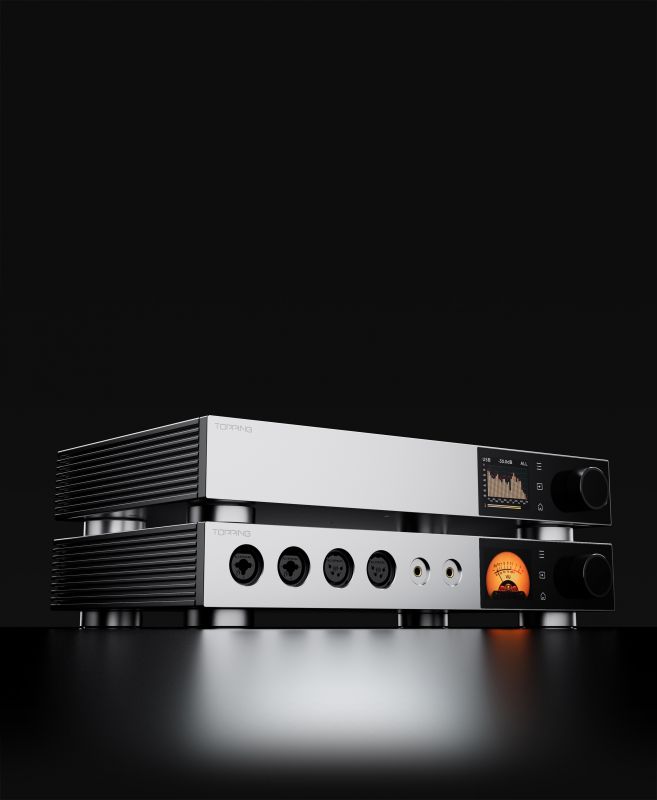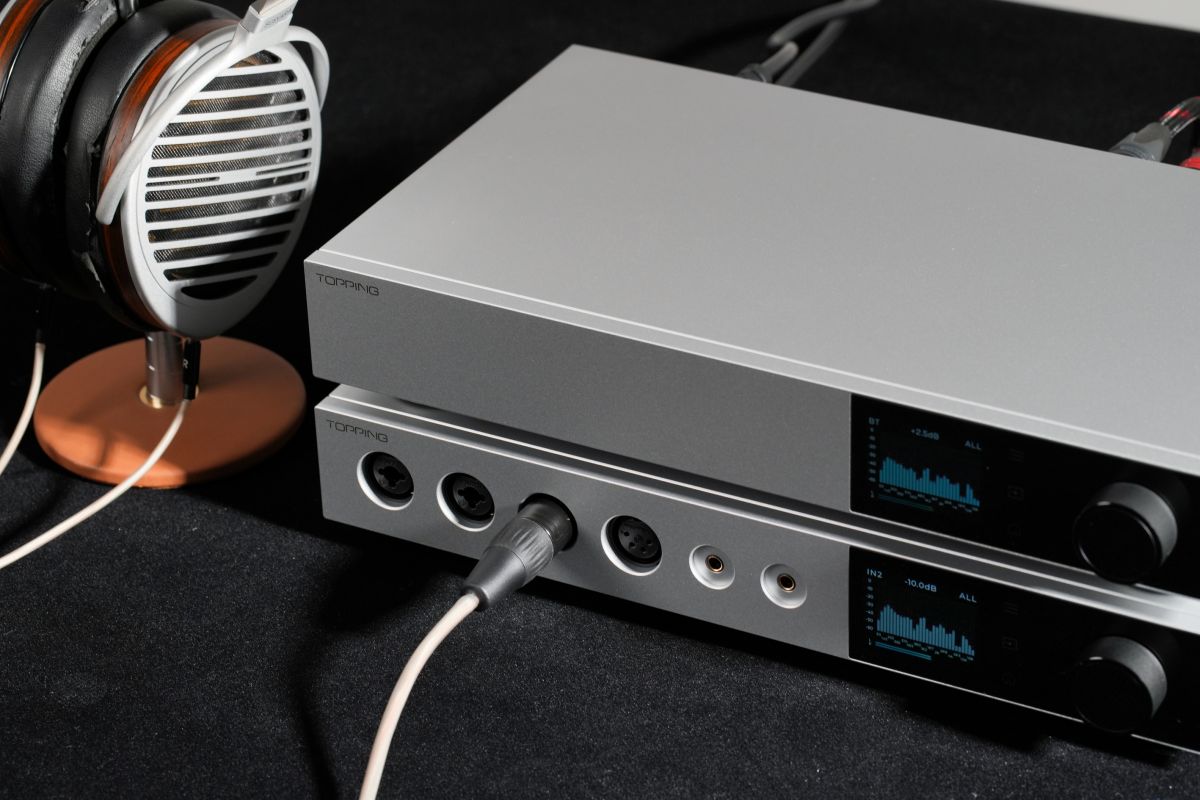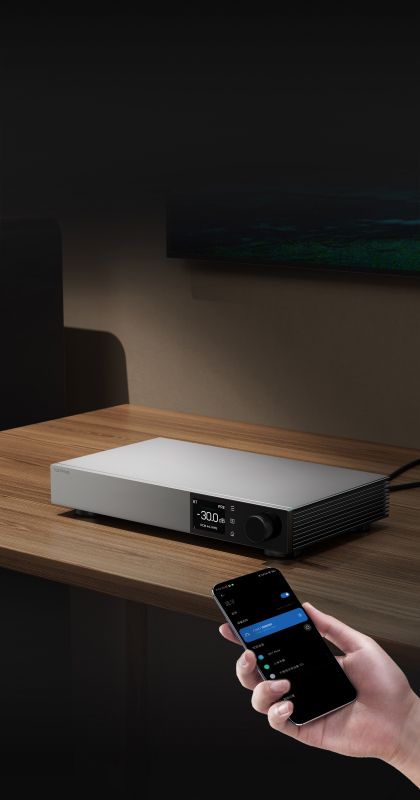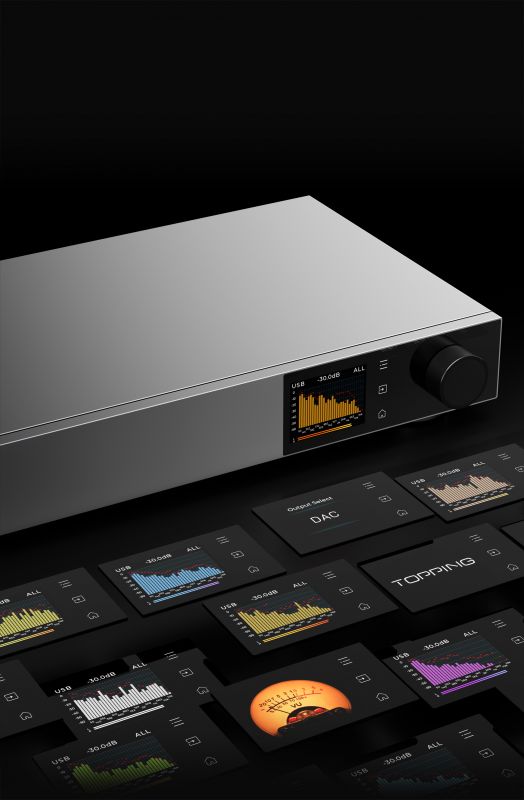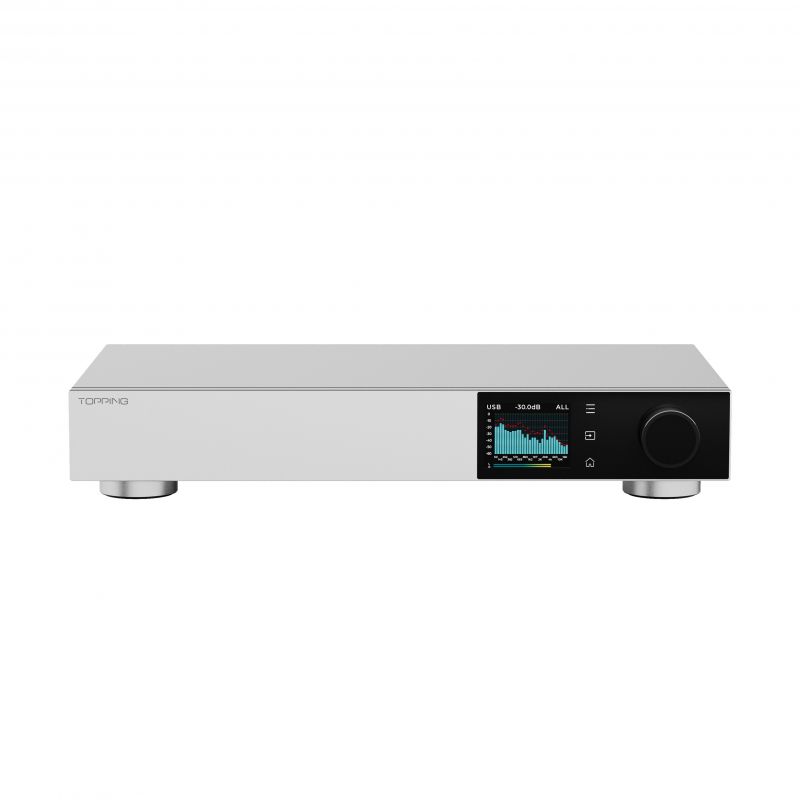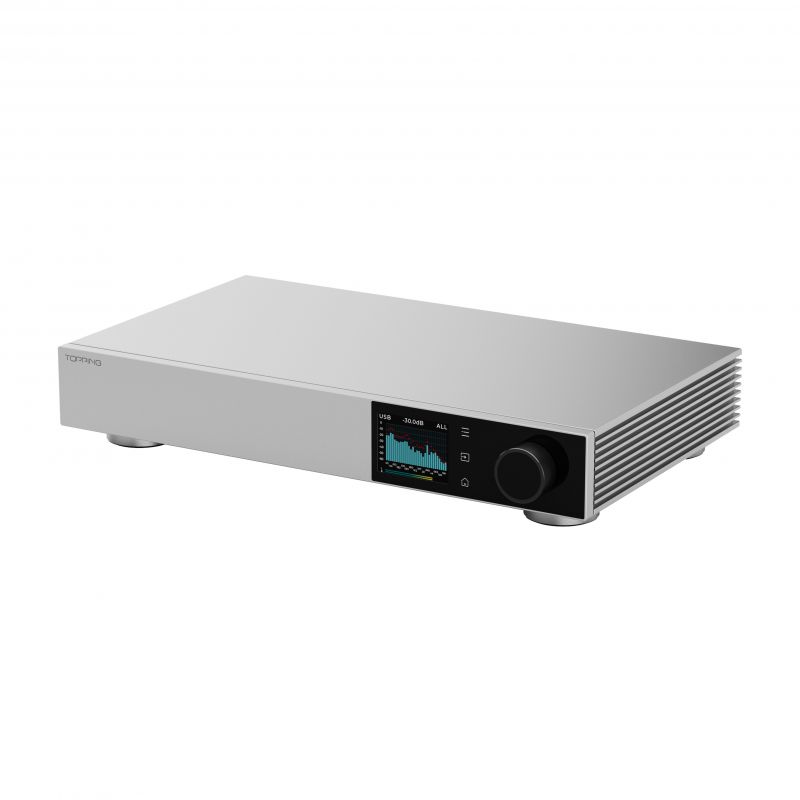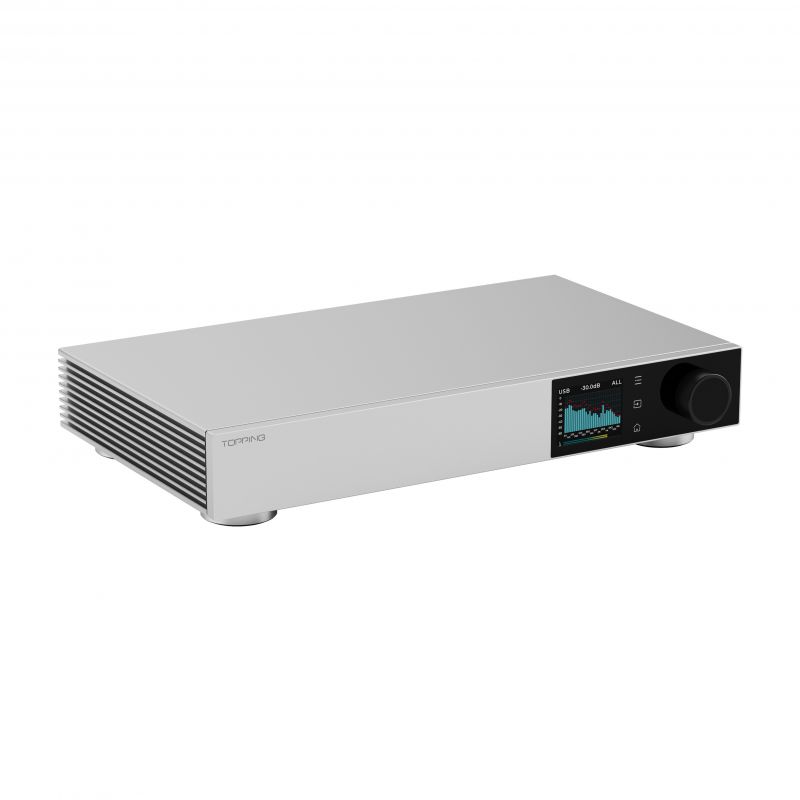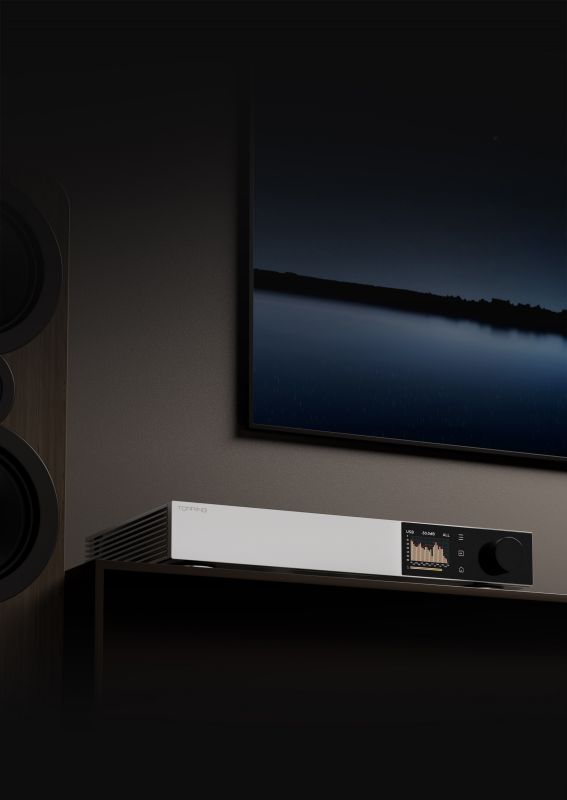DAC specialist Topping has released the finest DAC it has ever built: the new flagship D900. According to the manufacturer, the D900 is unlike any other DAC on the market at its price point.
Most manufacturers build their DACs around specialised, bought-in chips using ‘delta-sigma’ processing. A smaller number, termed ‘R2R’ DACs, use a ladder-like network of resistors instead of chips to convert digital signals to analogue. A third approach is to use programmable chips (FPGAs) to allow the manufacturer to write its own audio processing firmware.
Topping’s new flagship is distinct from all these other DAC designs, benefitting from innovative D-to-A conversion technology designed and built entirely in-house. Topping calls this ‘PSRM’ – a discrete 1-bit decoding architecture featuring an ultra-fast switching logic array and a precision voltage reference to accurately convert digital audio signals into analogue voltage. By minimising power supply interference and using careful component selection, PSRM technology achieves high audio accuracy, low noise and signal integrity.
PSRM – Topping’s technical tour de force
The D900 is not the first DAC to use Topping’s proprietary PSRM architecture – that was the D90 III Discrete, which launched in late 2024. But the company has further developed the technology for its new flagship DAC, perfecting its architecture until even the most ambitious design goals were achieved.
PSRM stands for Precision Stream Reconstruction Matrix and incorporates discrete 1-bit modules that convert digital audio streams into analogue voltage by turning each audio sample into a very fast train of 1-bit pulses. The density of this pulse train – the proportion of ‘ones’ versus ‘zeros’ – represents the instant waveform level; these pulses are then averaged/smoothed with an analogue reconstruction filter. In essence, this is a form of delta-sigma processing, but the implementation, algorithms and circuit choices are unique to Topping.
Compared to the D90 III Discrete, the D900’s sophisticated PSRM implementation doubles the number of elements in the PSRM module from 16 to 32. After rigorously evaluating dozens of component configurations, Topping selected a combination that delivers a fast response whilst preserving the integrity of the original signal. The component selection also minimises interference with the power supply system.
An accurate reference
The design of the voltage-reference power supply is critical because it directly determines the accuracy of the PSRM modules’ analogue output. Topping’s digital switching logic operates at the nanosecond level; while current fluctuations are regulated by these ultra-fast switches, they can still affect the purity of the reference voltage – an element that has a direct impact on noise and distortion.
To address this, Topping has developed a sophisticated voltage-reference power supply – stable, noise-free and purely resistive. The resulting synergy between this and the switching logic enables the D900 to reproduce the original audio signal with astonishing fidelity, achieving harmonic distortion below -140dB and a signal-to-noise ratio of 131dB. 3
What about Jitter?
Jitter – a timing error in digital audio signals that causes audible distortion – is eradicated by a sophisticated clocking system using a CPLD (Complex Programmable Logic Device) to optimise the signal. A CPLD is a type of programmable chip that delivers more predictable timing (in a digital data sense) than an FPGA chip owing to the way it is constructed, making it ideal for timing-critical digital applications.
High voltage
I/V (Current-to-Voltage) conversion is a necessary part of any DAC. It converts the initial current output from the digital-to-analogue conversion process into the voltage signal required by an amplifier, so the amp in turn can drive a pair or headphones or speakers and the quality of its implementation is critical to sound quality.
Topping has created a new, proprietary I/V conversion circuit to unlock the full potential of the D900’s PSRM DAC architecture, composed of low distortion integrated op-amps and ultra-low-noise discrete components carefully selected after repeated testing.
Pre-eminent preamplification
The D900 is a ‘pure DAC’ to use with digital sources in any high-performance audio system. It does not include an onboard headphone amp, although it can be paired with one, such as Topping’s matching A900. Keeping the headphone amp and DAC in separate chassis ensures both elements can be fully optimised to a level beyond any integrated solution.
In a high-end hi-fi system, the D900 is capable of competing with DACs costing several times its price. It can be connected to an integrated amp, or a pre/power amp system, via its line-level output; it also has a variable output, enabling direct connection to a power amp or a pair of active speakers, with no need for a separate preamp in-between.
The D900 is far from unusual in this regard. But not all DACs that claim to offer built-in ‘preamp’ functionality are equal – most simply apply a passive volume control or a digital attenuator, which is less sophisticated than a dedicated active preamp. The D900, however, includes a ‘proper’ analogue preamp stage with an independent, discrete circuit design that is a match for high-performance dedicated preamps, rendering a separate preamplifier unnecessary when used in a system with all-digital sources.
The D900’s volume control is a true high-end design, using 18 analogue relays (nine per channel) to deliver adjustment in 0.5dB steps. Whether the volume control is applied or the output fixed at line level, the Topping’s analogue stage – fully balanced from input to output – coupled to its unique PSRM D-to-A architecture delivers a high-end performance of remarkable quality at a relatively accessible price.
Well connected
There are eight cable inputs in total, including two USB (USB-C and USB-B) plus four S/PDIF (two optical and two coaxial). These are joined by an AES/EBU input and an IIS-LVDS (I2S) input, using XLR and HDMI connectors respectively – both are high-quality, low-interference digital audio connections that can provide superior performance in comparison to USB and S/PDIF, especially over longer cable runs.
The two USB ports and the IIS-LVDS input support PCM audio to 32-bit/768kHz, and DSD to DSD512 (native) and DSD256 (DoP). The other cable inputs handle PCM to 24-bit/192kHz and DSD64 (DoP only). In other words, the D900 processes all relevant digital file formats including the very highest of hi-res audio, now and in the future, without any sonic restriction.
Analogue outputs are provided in balanced XLR form for maximum sound quality, via high-grade Neutrik connectors. (Cables converting XLR to single-ended RCA can be used if connecting to an amp without balanced inputs.) There are two pairs of XLR outs – one delivering a fixed line-level signal, the other utilising the D900’s preamp circuitry.
Sonic tuning
The D900 supports Topping’s new PEQ (Parametric Equaliser) system, allowing precise control of frequency, gain and Q (bandwidth) across 10 customisable bands. By using the free ‘Topping Tune’ 5 software for Windows and Mac OS, in combination with an FPGA chip in the D900, users can create and save multiple profiles and upload them to the DAC; these can then be selected via the D900’s menu system without the software running in the background.
Topping Tune allows the user to create multiple sonic profiles and even import target curves. This enables the sound to be precisely tuned to suit the connected hi-fi or head-fi system, and the differing characteristics of digital sources and acoustic environments, in line with one’s personal sonic taste. (Utilising this facility is entirely optional, of course.)
With dimensions of 33×5.7x21cm (WxHxD), the D900’s lines are fashioned from aluminium – 3mm thick for the main casework and 8mm for the front panel and heatsinks on both sides.
The D900’s remote control is similarly well built – encased in aluminium machined from a single block – and can be used in combination with the D900’s two-inch colour screen and intuitive on-unit controls, which include touch-sensitive buttons and a multifunctional rotary control; the latter is programmable for easy access to the functions its owner uses most often.
The display is highly configurable thanks to Topping’s new Aurora UI, with nine different colour schemes, adjustable brightness and more. Users can choose to show data such as incoming file format, sample rate and volume level, or select a ‘spectrum analyser’ (FFT) display to represent the audio signal’s frequency components in real time. A third option is a classic VU-style meter, showing signal levels as the music plays and adding vintage appeal to this most modern of devices.
Topping’s new flagship headphone amp is now also shipping to the UK. It combines reference-class analogue headphone amp and preamp functionality and is the perfect headphone partner for the D900 (or any other high-performance head-fi configuration).
Under the hood, the A900 features Topping’s new ‘T’ang-ku-la’ architecture with a patented three-stage feedback circuit. This eradicates circuit noise and high-frequency distortion, thus further enhancing dynamic range to 151dB and reducing full-band total harmonic distortion to 0.00003% (90kBW)’. This new technology also reduces circuit heat generation, improving reliability and extending service life whilst minimising thermal noise.
The three T’ang-ku-la modules form a six-channel, fully differential architecture from input to output, thus achieving ‘full-link’ differential balanced amplification. The headphone amp delivers prodigious power of up to 22,000mW (@16 ohms). The manufacturer claims that no headphone on the planet is beyond the capabilities of the A900.
Its headphone ports allow the simultaneous connection of up to six pairs of headphones or IEMs, encompassing balanced 4.4mm, 4-pin XLR, 3-pin XLR and 6.3mm using premium Neutrik and Pentaconn connectors.
The A900 benefits from the same flagship level of specification as the D900, sharing the same build quality, machined aluminium remote control, relay-based volume control, PEQ functionality, colour display and Aurora UI interface.
With an RRP of £1,799, this new DAC/preamp is now shipping to the UK via Electromod, Topping’s official UK distributor.


